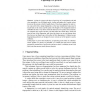Free Online Productivity Tools
i2Speak
i2Symbol
i2OCR
iTex2Img
iWeb2Print
iWeb2Shot
i2Type
iPdf2Split
iPdf2Merge
i2Bopomofo
i2Arabic
i2Style
i2Image
i2PDF
iLatex2Rtf
Sci2ools
AAECC
2003
Springer
2003
Springer
Fighting Two Pirates
A pirate is a person who buys a legal copy of a copyrighted work and who reproduces it to sell illegal copies. Artists and authors are worried as they do not get the income which is legally theirs. It has been suggested to mark every copy sold with a unique fingerprint, so that any unauthorised copy may be traced back to the source and the pirate who bought it. The fingerprint must be embedded in such a way that it cannot be destroyed. Two pirates who cooperate, can compare their copies and they will find some bits which differ. These bits must be part of the fingerprint, and when the pirates can see and change these bits, they get an illegal copy with neither of their fingerprints. Collusion-secure fingerprinting schemes are designed to trace at least one of the pirates in such a collusion. In this paper we prove that socalled (2,2)-separating codes often are collusionsecure against two pirates. In particular, we consider the best known explicit asymptotic construction of such ...
| Added | 06 Jul 2010 |
| Updated | 06 Jul 2010 |
| Type | Conference |
| Year | 2003 |
| Where | AAECC |
| Authors | Hans Georg Schaathun |
Comments (0)

